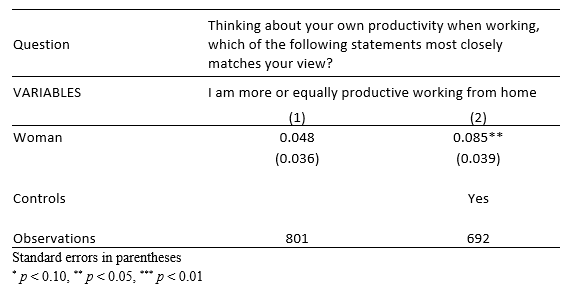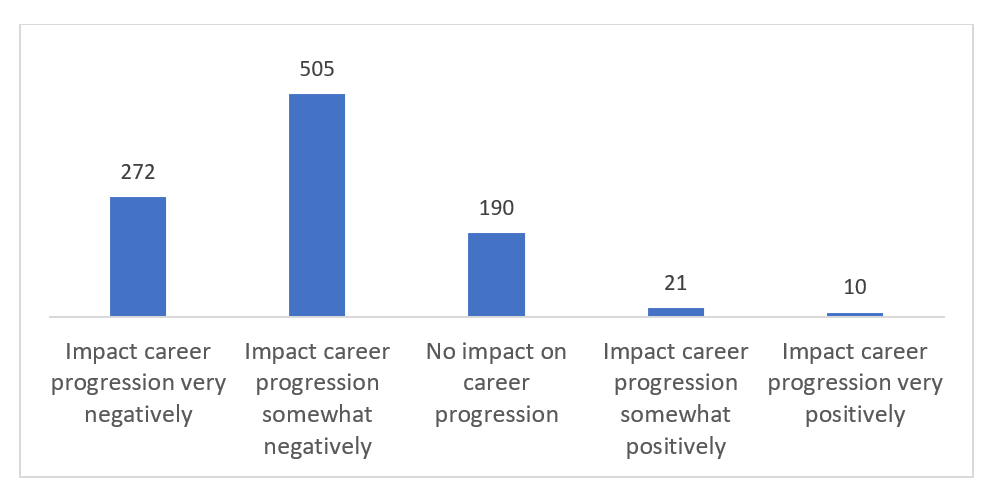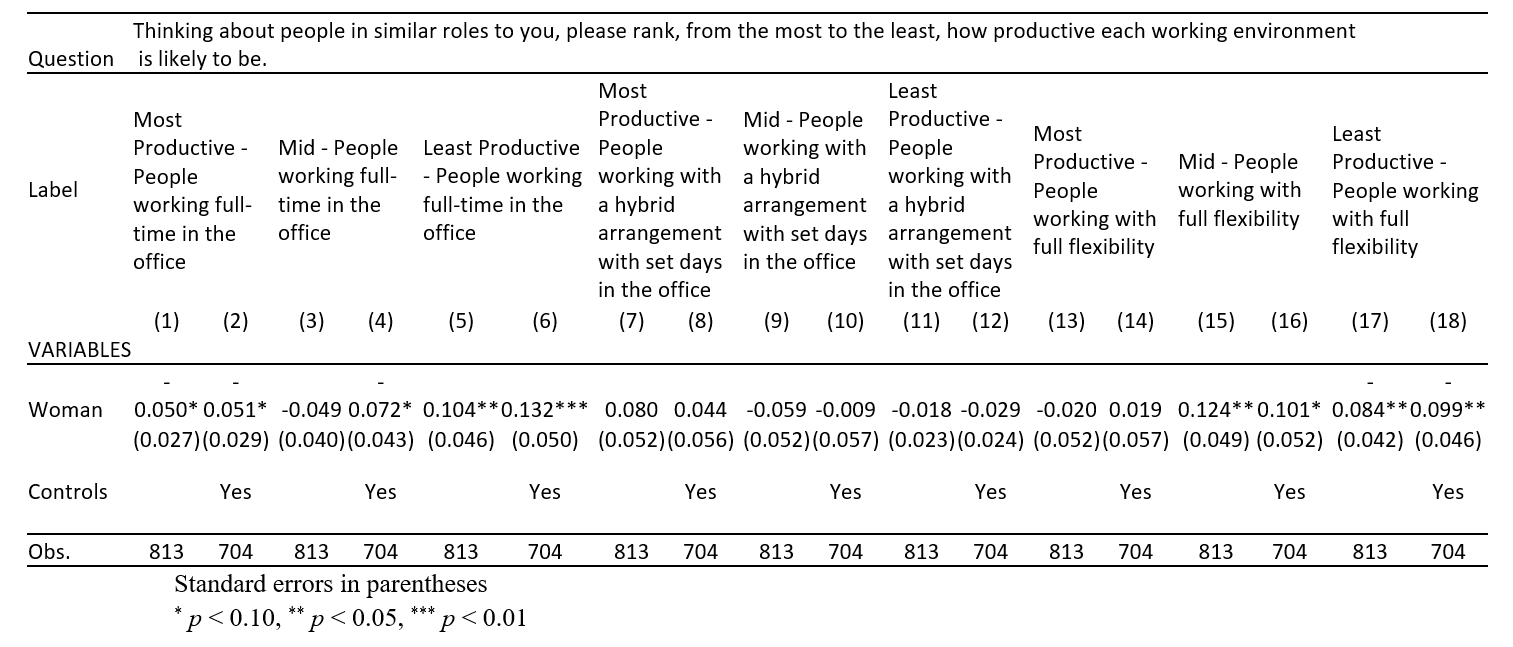There is a complex interplay between gender, remote work and productivity. Nikita, Anna Lane, Grace Lordan and Paul Middleton conducted a survey of more than 1000 employees in financial and professional services in the UK and found that men and women rank remote and hybrid working arrangements differently. The authors say that understanding these differences is key for an inclusive and productive work environment.
Do workers perceive themselves as more productive when they are given greater autonomy and are enabled to work remotely more often? To answer this question we conducted a survey of more than 1000 employees in financial and professional services in the UK to glean insights into contemporary perspectives on remote working, flexible working, productivity, and inclusion. We are particularly interested in how perceptions of the link between productivity and remote working differ between men and women. Overall, we find that women perceive hybrid working to be productivity enhancing. In contrast, men do not.
Past evidence
While the post-pandemic landscape has illuminated the remote work phenomenon, the impact of remote working on productivity has contrasting findings. Many pre-pandemic studies indicate a positive effect, including an 8 per cent productivity increase among call-centre workers in a natural experiment in the US and a 4 per cent gain in a work-from-anywhere initiative involving US Patent Office employees. Similarly, heightened productivity emerged through employee flexibility in an Italian company’s field experiment. Post-pandemic predictions estimate a 4.6 per cent productivity increase in the US, with over half attributed to time saved from commuting due to remote work.
In contrast, a study with 60,000+ Microsoft employees in the first half of 2020 indicated that the firm-wide remote work caused the collaboration network of workers to become more static and siloed, potentially leading to long-term productivity decline. Additionally, a 2019-2020 study in Japan proposed a dip in productivity associated with full-time remote work. Other research from Europe noted either unchanged or even decreased perceived productivity levels during the shift from office to remote work.
Because productivity is hard to measure in professional work, such studies often rely on measuring productivity based on perceptions. Intuitively, self-reports on productivity can be driven by beliefs and preferences. After all, if an individual prefers working in the office, they are more likely to feel productive while they are there.
Gender plays a role in remote work preferences. For example, previous research documents that, on average, women expressed a desire to spend 47 per cent of working days at home, compared to 43 per cent for men. A 2021 LinkedIn study also unveiled that women are 26 per cent more inclined than men to apply for remote job opportunities.
Measuring perceptions of productivity
In a multiple-choice question, respondents were asked to reflect on their own productivity when working at home vs working from the office. Eighty-one per cent (n=843) of the respondents chose the statement “I am more or equally productive working from home” over “I am more productive working in the office than from home” and “Don’t know / unsure”.
Table 1 summarises the marginal effects of the Probit regression on an outcome variable ‘I am more or equally productive working from home’ (takes the value 1 when participants chose this statement, 0 otherwise) to understand if there are any differences by gender in the responses received. The regression controlled for participant demographics such as age, occupation, work sector, full-time work status, and the number of working hours in a week.
In Table 1, we see that women are 8.5 percentage points more likely (approximately 11 times) than men to say “I am more or equally productive working from home”, with a 5 per cent level of significance.
Table 1. The effect of gender on the likelihood of perceived productivity at home vs office

This gender-related disparity in productivity perceptions indicates that women find remote work to be a more conducive environment for maintaining or enhancing their productivity levels, compared to their male counterparts. This is in line with previous research that suggests that women tend to be more productive during remote working. In a 2021 Gartner survey, women said there was no significant difference in working remotely or on-site for the majority of the work activities.
To gain a more comprehensive understanding of preferences for distinct working arrangements, the next step involves investigating whether men and women exhibit variations in ranking these work settings.
Perceived productivity rankings
Respondents are asked to assign a rank to each of the three working environments (full-time in the office, hybrid arrangement and full flexibility) based on their perception of their relative productivity levels. The ranking should indicate which working arrangement they believe would be the most productive (ranked as 1) and which would be the least productive (ranked as 3), with the remaining option ranked as 2.
Table 2 summarises the marginal effects of the Probit regression on all the responses to this question to understand if there are any differences by gender in the responses received. The regression controlled for participant demographics such as age, occupation, work sector, full-time work status, and the number of working hours in a week.
In response to the first statement, “People working full time in the office”, women are 13 percentage points more likely (approximately 20 times) than men to rank the statement as least productive, with a 1 per cent level of significance. No statistically significant differences were observed in the responses of men and women for the second statement, “People working with a hybrid arrangement with set days in the office”. In response to the last statement, “People working with full flexibility”, women have 10 percentage points (approximately 38 times) lesser probability than men of ranking the statement as least productive, with a 5 per cent level of significance.
Table 2. The effect of gender perceived productivity ranking for different working arrangements (click to enlarge)
The rankings assigned to different working environments reveal gender-specific perceptions of productivity. Women have a higher probability of ranking “People working full time in the office” as the least productive and a lower probability of ranking it as mid or most productive. This could indicate potential concerns related to the effectiveness of full-time in-office arrangements.
On the other hand, the absence of gender disparities in responses to the hybrid arrangement suggests a more balanced viewpoint across genders on hybrid working. Lastly, women’s lower probability of ranking “People working with full flexibility” as the least productive indicates their recognition of the potential benefits of flexible work arrangements, implying a positive shift towards valuing adaptability in work environments.
The implications of these findings resonate with the insights derived from Table 1, reaffirming that women perceive remote work as more conducive to their productivity, in contrast to their male counterparts. With these findings in mind, we now examine the perceived impact of fully remote working on an employee’s career progression.
Perceived impact of fully remote working
Respondents are asked to indicate their belief regarding how remote work choices may influence an employee’s career advancement within the organisation, ranging from highly negative to highly positive impact, or expressing uncertainty. About 78 per cent (n=777) of the respondents stated that “Remote working would impact their career very negatively or somewhat negatively”. Figure 1 shows the frequency of the responses.
No statistically significant differences were observed in the responses of men and women. The lack of disparity in responses between genders regarding the impact of remote work on career progression underscores a shared perception of negative impacts.
Research conducted in China provides evidence suggesting that, although remote workers tend to be more productive, their rate of promotion is notably lower compared to their in-office counterparts. While remote work options contribute to increased workplace diversity, this phenomenon raises concerns regarding diversity implications. Similarly, evidence from the US also suggests that despite the increased productivity of remote workers, they were significantly less likely to be promoted.
Furthermore, a study by Stanford revealed that employees believed their productivity was higher when working from home (around 7 per cent higher), while managers held the opposite view (approximately 3.5 per cent lower). The divergence in perception between employees and managers further compounds the challenge, potentially impeding career progression for those embracing remote work. As research indicates, it is women who are more likely to experience fear and encounter adverse career outcomes due to flexible working arrangements.
Figure 1. Perceived impact of fully remote working on an employee’s career progression

Finally, we aim to comprehend the factors that individuals believe contribute to enhanced productivity while working from home.
What helps increase productivity
Respondents were provided with a list of factors, and they were asked to indicate which ones, if any, contribute to an increase in productivity when they work from home. Upon statistically analysing the results, no differences were observed in the responses of men and women.
Figure 2 illustrates these perceived factors based on responses from participants. Key factors include the absence of commuting, fewer interruptions from colleagues, improved work-life balance, and the ability to choose one’s own hours. Notably, the most prevalent response, ‘no commuting,’ aligns with research that estimates a 4.6 per cent productivity increase in the US, with over half attributed to time saved from commuting due to remote work.
No statistically significant differences were observed in the responses of men and women. This absence of distinction highlights a shared perception among individuals about the factors that contribute to heightened productivity while working from home.
Figure 2. Factors perceived to contribute to an increase in productivity in work-from-home

Conclusion
The survey results cast a spotlight on the complex interplay between gender, remote work and productivity. Our findings underscore the confidence that women exhibit in their remote work capabilities, challenging traditional productivity norms. Additionally, the disparities in how different working arrangements are ranked showcase the evolving perceptions of productivity in a changing work landscape. As remote work continues to redefine professional paradigms, it becomes essential to embrace its differential effects on a diverse workforce to create a truly inclusive and productive work environment.
- This blog post represents the views of its author(s), not the position of LSE Business Review or the London School of Economics and Political Science.
- Featured image provided by Shutterstock.
- When you leave a comment, you’re agreeing to our Comment Policy.






